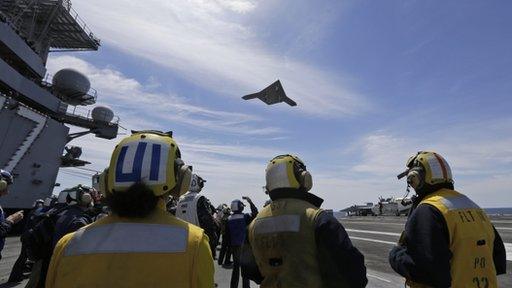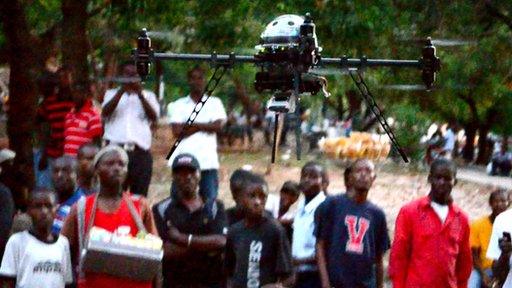TEDGlobal: Are drones tools of war or a social good?
- Published

Military drones need strict rules, thinks sci-fi writer Daniel Suarez
Speakers at the TEDGlobal conference have been debating the positive use of drones in society.
Delegates heard how drones, more usually seen as military tools, are increasingly playing a positive role in civilian life
They are offering new ways of transportation and carrying out vital conservation work.
But, warned one speaker, far stricter controls are needed over the use of such machines in war.
Sci-fi author Daniel Suarez called for international treaties to limit the use of autonomous combat drones that are increasingly being developed by nations such as the US and Israel.
"There are tonnes of great uses for unmanned drones but we need a framework for robotic weapons as it puts too much power into too few hands," he said.
"Increasingly combat drones are making lethal decisions about human beings."
In 2011 US drones created 300,000 hours of video surveillance, for example.
"This is outstripping the human ability to review it all so increasingly people will rely on visual intelligence software," said Mr Suarez.
He also warned of the threat of anonymous war, where terrorists or criminals could launch drone attacks which would be difficult to trace back. "Such a war would tilt the geo-political balance on its head," he said.
Delivering supplies

Tests in Haiti showed how drones can be used to deliver supplies
On a more positive note, delegates heard how drones can play a vital role in civilian life.
Andreas Raptopoulos is currently building a network of drones to provide vital supplies to hard-to-reach places.
"In sub-Saharan Africa 85% of the roads are unusable during the rainy season," he said.
"Imagine if you are in Mali with a newborn in urgent need of medication - it may take days to come."
To overcome the issue, he is using small flying vehicles known as octocopters, which can deliver goods such as medicine in a few hours.
The firm he has created, Matternet, grew out of a challenge set at the Singularity University in Silicon Valley to find solutions to global poverty.
Prototypes have been tested in Haiti, delivering supplies to camps set up in the wake of the 2010 earthquakes and the firm is now planning a wider trial of the technology.
The method is cheap. "To deliver 2kg [4.4lb] over 10km [6.2 miles] costs just 24 cents," he said, although currently a vehicle costs about $3,000 (£1,900).
Mr Raptopoulos hopes to bring costs down to around $750 (£480) per vehicle.
He thinks that the project has huge potential.
"This could be the next big network, offering millions of people access to better medication and other supplies in the same way as the mobile network offered them access to the internet," he said.

Drones are helping to count dwindling orangutan populations
Such drones could also have a future in the heavily congested megacities of the future, delivering goods to businesses and consumers much more quickly and efficiently.
Orangutan nests
Meanwhile, Lian Pin Koh showed off how basic model aircraft fitted with video cameras, autopilot systems and software to programme them can become vital conservation tools.
"For the price of a decent laptop we can built a conservation drone with tremendous potential to monitor the health of wildlife and combat wildlife crimes," said Prof Koh.
Traditionally, orangutan populations have been measured by sending teams into the forests of Sumatra with binoculars to find them
Now airborne drones are finding dozens of nests in the trees and, with the help of automated software, are making the process far more efficient.
Subsequent systems have been used to map the health of forests, showing where illegal logging is taking place, where forests are contracting and plantations expanding.
- Published23 May 2013
- Published27 April 2013
- Published30 May 2013